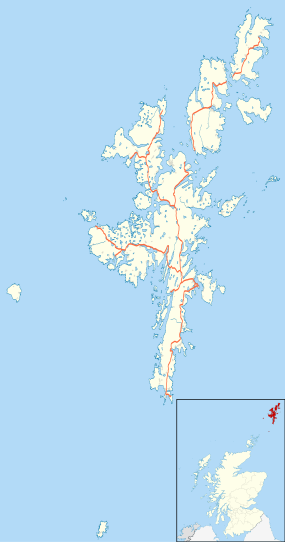Old Scatness

Aerial view of the archaeological dig
|
|
| Location | Mainland, Shetland |
|---|---|
| Coordinates | 59°52′44″N 1°18′19″W / 59.879°N 1.3054°W |
| Type | Broch and settlement |
| History | |
| Periods | Iron Age, Pictish, Viking |
Old Scatness is an archeological site in the parish of Dunrossness in the South Mainland of Shetland, near Sumburgh Airport consisting of mediaeval, Viking, Pictish, and Iron Age remains. It has been a settlement for thousands of years, each new generation adding buildings, and leveling off old ones. Among the discoveries is an Iron Age broch.
The site was first unearthed during construction work for airport improvements in the late 1970s. An arc of the broch wall was exposed in one side of a green mound during the building of the perimeter road at the airport at Sumburgh Head. Since 1995, University of Bradford staff and students, professional archaeologists and local volunteers have been excavating the site and cataloging the finds. Excavations have uncovered a multi-period settlement with broch, wheelhouses and later dwellings.
The site is managed by the Shetland Amenity Trust. In the summer, costumed guides provide tours of the site and the replica Iron Age and Pictish buildings. The visitor centre also includes exhibits, and there are demonstrations of ancient crafts.
The broch still stands several metres high with a battered outer wall face. The broch stands at the centre of the settlement and seems to have at least three major phases of use. The first phase saw the building of the primary tower. The second phase saw a rebuilding of the broch interior which involved the addition of a secondary skin to the south and east part of the inner broch wall, and a set of radial piers to form a new interior structure. In the third phase another building was constructed inside the broch, consisting of six or more curvilinear cells clustered around a central area, with a corridor leading out towards the broch wall to the east.
To the western (seaward) side of the broch the limits of the settlement have been established. The dominant feature was a large circular aisled roundhouse (Structure 12) around 10 metres in diameter. The walls of this building stand to over 2 metres high in places. To the west of this was a second building less well-preserved. To the south of Structure 12 was another roundhouse (Structure 14) of a similar size but oval in shape. To the north of Structure 12 was another range of buildings, including one with a set of seven (possibly originally eight or more) small 'cupboards' let into the interior wall. East of this building and closer to the broch, a circular inward-tilting arrangement of stones appeared to be the partially collapsed top of the roof of a corbelled cell.
...
Wikipedia

